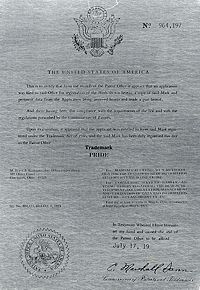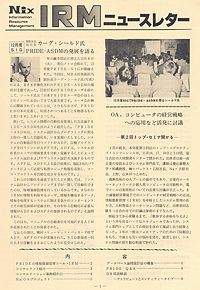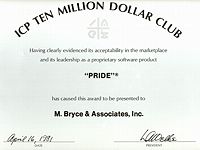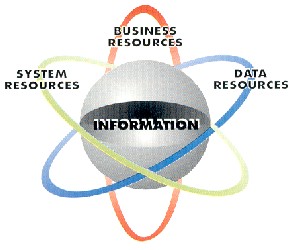|
WHAT IS "PRIDE"?
"PRIDE" is an integrated approach to Information Resource Management (IRM)
consisting of three complementary methodologies for developing and managing business
resources (Enterprise Engineering Methodology), systems resources (Information Systems
Engineering Methodology), and data resources (Data Base Engineering Methodology). There
is also a Project Management system and supplemental narratives describing the
infrastructure and support mechanisms required by "PRIDE."
We refer to "PRIDE" as the "science of Information Resource Management" because
it has a strong conceptual foundation that has stood the test of time. There is
no exotic concepts or terminology in "PRIDE." All of its concepts and terminology
have been defined, tested, and applied in just about every field of endeavor imaginable.
The "PRIDE" principles are derived from engineering and manufacturing and
are used to create an "Information Factory" environment for the development of
information resources, complete with assembly lines (methodologies), production
control (project management), and materials resource management (IRM
resource management). As such, "PRIDE" provides the organizational framework
for all IRM development activities and promotes the sharing and re-use of
information resources, thereby fostering the integration of systems, and data.

NOTE: Click on graphic to enlarge. Click 'Back' to return.
The intent of the methodologies is to define the "5W's" (Who is to perform,
What task, When, Where, and Why). A variety of tools and techniques can be deployed
in "PRIDE" in an integrated manner, thereby defining "How" the work is to be
performed. Thus, :PRIDE" brings organization to the development environment and
gets developers operating in a concerted effort. "PRIDE,"
therefore, is used to improve productivity and promote the development of
quality deliverables. For more information on productivity, see the M&JB paper
Moving IRM from an Art to a Science.
THE NEED FOR BASIC MANAGEMENT
| WITHOUT... | THE RESULT... |
| Organization and Discipline
| Communications break down.
Inconsistent results emerge.
Quality suffers.
|
| Accountability
| People do not feel responsible for producing results.
Excuses run rampant.
The "loose cannon" phenomenon occurs.
|
| Planning & Measurable Benchmarks
| Projects lose direction (almost immediately).
Companies are bilked of funds.
"Firefighting" becomes the norm.
|
| Product Specifications
| Time/money is lost "second-guessing" what is to be produced.
|
| Controls
| Cannot monitor or use resources to maximum effect.
Cannot measure success (or failure).
|
WITHOUT EFFECTIVE MANAGEMENT, CHAOS REIGNS
Implementing an Information Factory a la "PRIDE" is part of
a natural maturation process as defined by M&JB's paper,
The Four Stages of Growth and
their book The IRM Revolution: Blueprint
for the 21st Century (ISBN 0-9621189-0-7).
WHO SHOULD USE "PRIDE"?
"PRIDE" is used by a variety of people...
- Analysts studying the business and formulating an enterprise-wide
information strategy.
- Systems and software personnel building or re-engineering systems.
- Data Base personnel developing the corporate data base.
- Managers planning, estimating, scheduling, and controlling projects and
allocating human resources.
- End-users inputting specifications and participating in project activities.
- Senior Management monitoring the development environment.
In the early days of "PRIDE," the product was only made available through
a proprietary purchase agreement with M&JB.
NOW, THIS VALUABLE APPROACH TO IRM IS AVAILABLE IN BOOK FORM;
CLICK HERE. This means, "PRIDE" is now
available to everyone. By putting "PRIDE" in the public domain, it is hoped
that it becomes an industry standard.
In addition to companies and organizations being allowed to use "PRIDE,"
it is hoped that colleges and universities adopt it in the classroom. Because
of the comprehensiveness of "PRIDE," it offers tutorials supporting a
broad curriculum of business systems.
Although "PRIDE" is free to use, it is subject to certain terms and
conditions (see "Terms of Use" on the "PRIDE" cover page). Fundamentally,
the "PRIDE" user agrees to observe the copyright and trademark notation
used in the product.
"PRIDE" TRAINING
NEED MORE INFORMATION? M&JB offers on-site training in the use of "PRIDE," either standard
offerings or custom-tailored to support the needs of a customer. Subjects include:
- THE SCIENCE OF IRM - describing the concepts and principles of Information
Resource Management and how to create an "Information Factory" environment.
- BUSINESS MODELING - how to perform an Organization Analysis by defining
the enterprise logically and physically.
- PRODUCING AN ENTERPRISE INFORMATION STRATEGY (EIS) - how to produce a
prioritized list of business objectives and supporting projects ("Priority Modeling").
- DOCUMENTING LEGACY SYSTEMS - how to document existing systems and re-use
vital resources from them.
- DESIGNING INTEGRATED SYSTEMS - how to develop a complete system architecture,
along with tips for making systems universally applicable across geographical lines.
- RE-ENGINEERING BUSINESS PROCESSES - how to document and modify business processes.
- WRITING USER MANUAL AND HELP TEXT - including the "Playscript" technique
- SPECIFYING SOFTWARE REQUIREMENTS - what Software Engineers should know
in order to effectively program.
- DESIGNING/MODELING THE LOGICAL DATA BASE - how to define objects and
their views, both at the "application" and "enterprise" levels.
- PROJECT MANAGEMENT PLANNING - how to define a Work Breakdown Structure (WBS) and
establish precedent relationships also, performing resource allocation.
- PROJECT MANAGEMENT ESTIMATING/SCHEDULING- how to perform both a Detail
and Order-of-Magnitude estimate, and scheduling using "Effectiveness Rate."
- CREATING AN IRM REPOSITORY - defining the types of resources to be included
in a repository and how to physically implement it.
- CREATING A PROJECT MANAGEMENT SYSTEM - how to buy or build an integrated
PM system.
- "PRIDE" IMPLEMENTATION - how to install the methodologies and the
necessary infrastructure and supporting tools.
- "PRIDE" METHODOLOGY TUTORIAL - concepts and methodology construction
is explained for either "PRIDE"-EEM, ISEM or DBEM.
PRICING: All courses are organized into one day increments @ $2,000 (U.S.)
per day plus travel expenses. For additional information about these on-site
courses or to schedule a class, contact M&JB.
"The company conducts business with many of the most prominent companies
from around the globe and brings together professionals from many different
geographical locations."
"With such skilled workers, the company stays in tune with the products and
services it markets and the individual needs of its diverse customer base."
"M&JB is certainly a leader in its field."
- DATAPRO
"PRIDE" MILESTONES

1971: "PRIDE" Trademark Registration
|

"PRIDE" has been used in Japan since 1976
|

One of many sales awards won.
|

STATE OF MINNESOTA
SAINT PAUL
1977 SESSIONS
STATUTE 455, SECTION 64
"COMPUTER SYSTEMS DEVELOPMENT"
In all cases where an appropriation made in this act includes
money for computer systems development, development shall not
proceed beyond "PRIDE" Phase 1 until project has been reviewed
and approved by Commissioners of Administration and Finance.
All approved projects shall be reported to the Chairmen of
the House Appropriations Committee and the Senate Finance
Committee to receive their recommendations on the project.
A recommendation is advisory only. In the case of rejected
projects, the Commissioner of Finance shall cancel the
unencumbered balance of the appropriation allotted for development
of the project.
Act covers Fiscal Years 1978 and 1979
(from July 1, 1977 through June 30, 1979)
1978: 1st methodology enacted into law
|
THE HISTORY OF "PRIDE"
|
1971
|
M&JB is founded as M. Bryce & Associates (MBA) introduces "PRIDE" (PRofitable Information by DEsign -
through phased planning and control). "PRIDE" is the world's first commercially
available Methodology for developing systems (the term "Methodology" was
coined by "PRIDE"); first Structured Systems Design Technique (Chronological
Decomposition); and first Data Dictionary/Directory. It also includes
Documentation and a Project Management System, all integrated into a single product.
|
|
1974
|
"PRIDE"-LOGIK, Logical Organizing and Gathering of Information
Knowledge, is developed by M&JB using the "PRIDE" methodology.
"PRIDE"-LOGIK is an automated Data Dictionary/Directory. It
is designed to complement the Data Management and Documentation
techniques of "PRIDE."
|
|
1976
|
M&JB establishes representation in Japan, the start of a long relationship
in the land of the rising sun.
|
|
1977
|
"PRIDE" becomes the first commercial methodology enacted into law
(State of Minnesota - see above).
|
|
1979
|
The Automated Design Facility (ADF) is developed by M&JB as a productivity
tool which is used to automatically design Information Systems and
logical Data Bases. It is the world's first "Systems Generator" (not to be
confused as a "Program Generator"). Based on Information Requirements, ADF
automatically designs a system into its sub-systems, procedures, and programs,
as well as design the logical data base and suggest physical files. By accessing
the IRM, ADF promotes the sharing and re-use of data resources.
Also in December, M&JB wins its lawsuit with AMF-Harley Davidson and Arthur Young,
Company in Milwaukee, Wisconsin. A jury determines that "PRIDE" is a unique
product and that M&JB took all of the necessary steps to protect it, thus making
it a trade secret. They also determine that Arthur Young was guilty
of trying to misappropriate the product.
|
|
1981
|
M&JB enhances "PRIDE"-LOGIK and retitles the product, the Information
Resource Manager (IRM) and the name "PRIDE"-LOGIK is dropped.
M&JB demonstrates program generation by developing an interface from
the IRM to the System-80 COBOL program generator. Between ADF and
the IRM's interface to program generators, M&JB successfully demonstrated
100% systems generation.
|
|
1982
|
M&JB announces "PRIDE"-ASDM, Automated Systems
Design Methodology. "PRIDE"-ASDM is a major development effort by
M&JB and includes Automated Instructional Materials (AIM).
|
|
1984
|
"PMC2" (Project Management - Command & Control) is introduced
by M&JB. It represents the automation of the Project Management
activities in "PRIDE".
|
|
1985
|
M&JB relocates its offices to Palm Harbor, Florida.
|
|
1986
|
M&JB unbundles and restructures its product line consisting of
manual and automated combinations of ISEM (Information Systems
Engineering Methodology), IRM, and PMS (formerly "PMC2").
|
|
1987
|
M&JB introduces "PRIDE"-Data Base Engineering Methodology
(DBEM). DBEM introduces the concepts of "objects", 4 data base models,
and "Data Taxonomy."
Also, ADF is enhanced and renamed ASE (Automated Systems Engineering)
|
|
1988
|
M&JB introduces "PRIDE"-Enterprise Engineering Methodology (EEM).
EEM introduces the techniques of "Enterprise Decomposition" and
"Enterprise Information Strategy" (EIS)
M&JB develops automated support for "PRIDE"-EEM in the form of
"PRIDE"-CAP (Computer Aided Planning) to model and communicate priorities,
group information requirements and objectives, and to perform an
Organization Analysis (the first such product to do so).
M&JB publishes book,
"THE IRM REVOLUTION: BLUEPRINT FOR THE 21ST CENTURY" (ISBN: 0962118907). Book
quickly makes the top ten list in Japan.
|
|
1990
|
M&JB unveils the "PRIDE"-Information Factory, an OS/2 based
implementation of the "PRIDE" product line.
|
|
1993
|
M&JB enters into agreement with the American Management
Association (AMA) to conduct a series of IRM Executive Seminars
|
|
1994
|
M&JB announces "PRIDE"-PC, a PC implementation of its
Automated Instructional Materials (AIM).
|
|
1996
|
M&JB and "PRIDE" celebrates its 25th birthday.
|
|
2006
|
M&JB and "PRIDE" celebrates its 35th birthday.
|
|
2011
|
M&JB and "PRIDE" celebrates its 40th birthday.
|
|
2016
|
M&JB and "PRIDE" celebrates its 45th birthday.
|
|
2021
|
M&JB and "PRIDE" celebrates its 50th birthday. "Who-da-thunk-it?"
|
|
|


